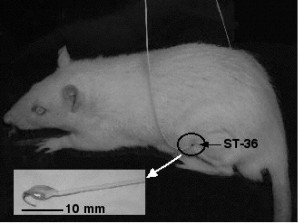Jul 24 2015
Another Study that Doesn’t Show How Acupuncture Works
 The pattern is now quite familiar – a study looking at some physiological outcome while rats or mice are being jabbed with needles is breathlessly presented as, “finally we know how acupuncture works.” As is always the case, a closer look reveals that the study shows nothing of the sort.
The pattern is now quite familiar – a study looking at some physiological outcome while rats or mice are being jabbed with needles is breathlessly presented as, “finally we know how acupuncture works.” As is always the case, a closer look reveals that the study shows nothing of the sort.
The current study making the rounds is, “Effects of Acupuncture, RU-486 on the Hypothalamic-Pituitary-Adrenal Axis in Chronically Stressed Adult Male Rats.” We are told that acupuncture has the same effect as pain medication, but honestly I don’t see that anywhere in the study.
The study presents two experiments with rats in which there is a control group, a stress group, stress plus acupuncture, and stress plus sham acupuncture. The first thing to notice is that the rats were not actually getting acupuncture. They were getting the fiction known as “electroacupuncture.” Electroacupuncture is not a real thing – it’s just electrical stimulation through a needle which is called an acupuncture needle.
The authors claim that their results show that electroacupuncture (EA) at the St36 acupuncture point (which is behind the leg), but not sham EA on the back blunt the stress response as measured by cortisol levels, ACTH, and stress behavior in the rats.
Just looking at the data itself, separate from the context of acupuncture, there are a few things to notice. The first is that the study is very small, with (in the first experiment) 7 rats in the control and stress groups, and 14 rats in the EA and sham EA groups. That’s not a lot of data points. There is no mention of blinding anywhere in the study. Unless everyone involved in those aspects of the study measuring outcomes were effectively blinded, I see no reason to take the results seriously.
Further, the results are completely unimpressive. The differences are slight. The researchers also pull a common statistical trick. They say, for example, that the difference between control and EA was statistically significant, while the difference between control and sham EA was not. However, they don’t tell us whether or not the difference between EA and sham EA was significant (and by looking at the data I would guess not).
It is therefore not valid to conclude that there is a difference between EA and sham EA. This is a common statistical “mistake” researchers make, probably having something to do with the fact that it makes negative data look positive.
It is possible that this study tells us nothing at all. Given the small number of rats in the study, no documentation about blinding, and the unimpressive results, just a touch of researcher bias (exploiting those researcher degrees of freedom) is all that is necessary to get the graphs to look good enough to publish.
Therefore, regardless of the subject matter, these are preliminary results at best, and unimpressive preliminary results at that.
If we put these results into the context of acupuncture, we then have the equivalent of Bem’s psi research – unimpressive results used to support a massive claim.
Let’s be clear – acupuncture points are a complete fiction. They are pre-scientific superstition and nothing more. There is no science to support their existence – nothing in physiology, anatomy, biology, biochemistry, or neuroscience supports the existence or even the plausibility of acupuncture points. They simply have no basis in reality.
Claiming that acupuncture points are real would therefore be an extraordinary claim. It would establish an entirely new physiological phenomenon previously completely unknown to science. A small unblinded study in rats with unimpressive results is not going to establish that, any more than Bem’s razor thin results establish that time travel is possible.
There are a few ways, therefore, to interpret these results. The first is that the results are completely unreliable and need no specific explanation. It is also possible that researcher bias simply gave the acupuncturist running the study the results she expected.
It’s also possible that there is a physiological difference between shocking rats on the back and shocking rats behind the leg, having nothing to do with acupuncture. We know that electrical stimulation can moderate the effects of other stimuli or pain. We use transdermal electrical nerve stimulation to treat chronic pain.
In fact you could present this very study, the exact protocol and results, and never mention the word acupuncture. You could present this study as, “Transdermal electrical nerve stimulation is more effective on the hind back than behind the legs in a rat model of stress.” I still wouldn’t be impressed with the results, but at least the authors would not be gratuitously supporting a pseudoscience. This shows the importance of context in research.
Conclusion
This small study can be comfortably ignored. The results are unimpressive, the main objective is actually not presented as statistically significant, and the conclusions are gratuitous and not supported by the data.
The study does not, in fact, show “how acupuncture works.” I would argue it has nothing to do with acupuncture because it used electrical stimulation.
Further, any study that claims that acupuncture points are real is immediately called into question. I would take only the most rigorous protocol with clear cut results seriously, and this study is not it.






